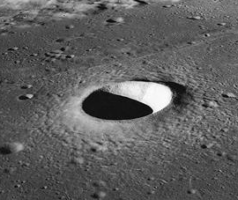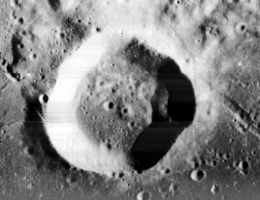
StarCo by Ludo Coppens © 2014-2023 ludo.coppens(at)kineco.be
Select a crater by clicking on the image. Move the mouse over the full scale image of the larger region to show names of prominent surface features and additional data: depth from rim to crater floor and diameter, taken from the Times Atlas of the Moon (Ed. H.A.G. Lewis, Times Newspapers Ltd., 1969; charts available online at http://www.lpi.usra.edu/resources/mapcatalog/LAC/) and from Virtual Moon Atlas (Christian Legrand & Patrick Chevalley).
Abenezra 
Abetti 
Agrippa 
Alexander 
Alfraganus 
Aliacensis 
Almanon 
Alphonsus 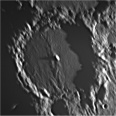
Ammonius 
Anaxagoras 
Anaximander 
Angström 
Anville 
Arago 
Archimedes 
Archytas 
Ariadaeus 
Aristarchus 
Aristillus 
Aristoteles 
Artsimovich 
Arzachel 
Autolycus 
Azophi 
Babbage 
Baillaud 
Baily 
Bancroft 
Barocius 
Barrow 
Bayer 
Beer 
Bettinus 
Bianchini 
Biot 
Birmingham 
Birt 
Blancanus 
Blanchinus 
Bode 
Boguslawsky 
G. Bond 
W. Bond 
Bonpland 
Borda 
Borel 
Boscovich 
Bouguer 
Bradley 
Brewster 
Brown 
Buch 
Bullialdus 
Bürg 
Cabeus 
Calippus 
Campanus 
Capuanus 
Carpenter 
Casatus 
Cassini 
Catharina 
Cayley 
Chacormac 
Chladni 
Cichus 
Clairaut 
Clausius 
Clavius 
Cleomedes 
Clerke 
Conon 
Copernicus 
Cuvier 
Cyrillus 
Cysatus 
d' Arrest 
Daniell 
Dawes 
Debes 
Delambre 
Delisle 
Deluc 
Dembowky 
De Morgan 
Demonax 
Dionysius 
Diophantus 
Doppelmayer 
Dunthorne 
Egede 
Elger 
Encke 
Epigenes 
Epimenides 
Eratosthenes 
Euclides 
Euctemon 
Eudoxus 
Euler 
Faraday 
Fauth 
Fedorov 
Feuillée 
Fontenelle 
Foucault 
Fra Mauro 
Franck 
Freud 
Galle 
Gassendi 
Gauricus 
Geber 
Godin 
Goldschmidt 
Grove 
Gruemberger 
Gruithuisen 
Guericke 
Gylden 
Hainzel 
Hall 
Harpalus 
Heinsius 
Helicon 
Herigonius 
Herodotus 
Herschel 
Hesiodus 
Hippalus 
Horrebow 
Huxley 
Hyginus 
Hypatia 
I bn Rushd 
J. Herschel 
Julius Caesar 
Kant 
Kepler 
Kiess 
Klaproth 
Klein 
Konig 
Kruzenstern 
Kunowsky 
La Caille 
La Condamine 
Lade 
Lagalla 
Lamech 
Lee 
Le Monnier 
Lepaute 
Letronne 
Licetus 
Lindbergh 
Lindenau 
Littrow 
Longomontanus 
Lubbock 
Lubiniezky 
Luther 
Macmillan 
Macrobius 
Maestlin 
Manilius 
Manners 
Maraldi 
Marinus 
Mason 
Maupertuis 
Maurolycus 
C Mayer 
Mee 
Menelaus 
Mercator 
Messier 
Meton 
Mitchel 
Montanari 
Moretus 
Mouchez 
Müller 
Murchison 
Nasmyth 
Neison 
Newton 
Nicollet 
Noggerath 
Opelt 
Pallas 
Parrot 
Parry 
Peirce 
Philolaus 
Phocylides 
Piazzi Smith 
Picard 
Piccolomini 
Pickering 
Pictet 
Pitatus 
Plana 
Playfair 
Plato 
Plinius 
Posidonius 
Prinz 
Proclus 
Protagoras 
Ptolemaeus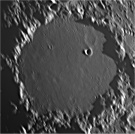
Puiseux 
Purbach 
Raman 
Ramsden 
Regiomontanus 
Reiner 
Ritter 
Robinson 
Rømer 
Ross 
Rost 
Rothman 
Rutherfurd 
Sabine 
Saunder 
Scheele 
Scheiner 
Schickard
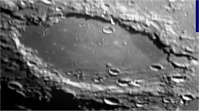
Schiller 
Schmidt 
Schomberger 
Scoresby 
Sheepshanks 
Short 
Silberschlag 
Simpelius 
Sosigenes 
South 
Spurr 
Stadius 
Stiborius 
Street 
Swift 
Tacitus 
Taquet 
Taylor 
Tempel 
Theaetetus 
Thebit 
Theon junior 
Theon senior 
Timaeus 
Tisserand 
Tolansky 
Toscanelli 
Tralles 
Triesnecker 
Trouvelot 
Turner 
Tycho 
Ukert 
Vaisala 
Very 
Vitello 
Vitruvius 
Wallace 
Wargentin 
Weigel 
Weiss 
Werner 
Whewell 
Wichmann 
Wilhelm 
Wilson 
Winthrop 
Wrottesley 
Wurzelbauer 
Yerkes 
Zöllner 
A crater is a roughly circular depression in the lunar surface, caused by the impact of a solar system body (asteroide, comet, meteorite). Small craters (up to 20 km diameter) tend to have a shallow bowl-shape with raised rim. With increasing size (up to 50 km diam.) floors become flat and inner walls tend to slump. Still larger ones mostly have terraced inner walls and a central peak (caused by rebound of lunar rock). Above about 200-300 km, other names apply: lacus, mare. Most large craters date from early solar system history: 4.5-3.8 Gy ago.
(At right: images of three types, taken from orbit; not to scale; © NASA)
